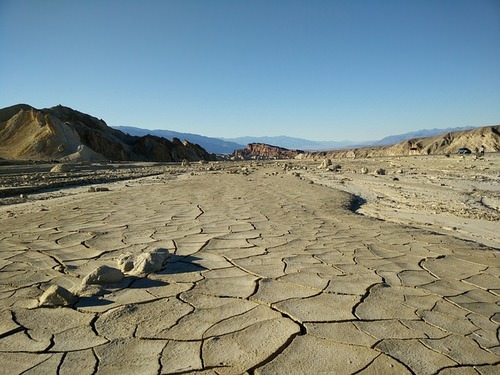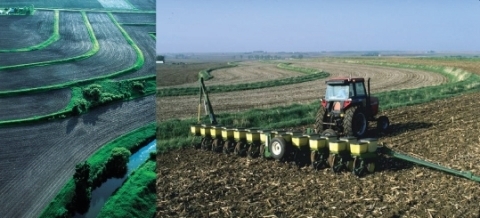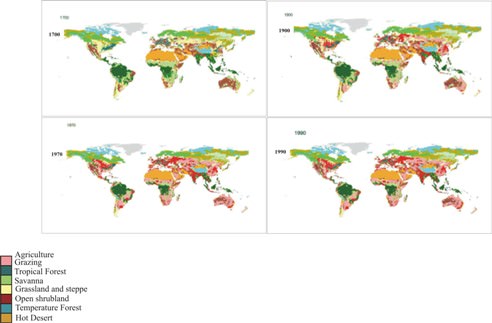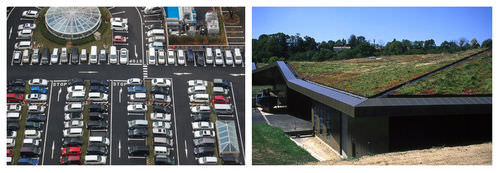18.43 土壤和土地资源 -- -- 先进
章节大纲
-
Could this land be used for ?
::这块土地能用来吗?Probably not. The quality of soil is very important in determining what can grow in a particular area. Good soil is not so easy to come by. Soil should be considered another resource that we, as a , must strive to protect.
::土壤质量对于确定在特定地区可以种植什么非常重要,良好的土壤并非易得。 土壤应被视为我们作为一个国家必须努力保护的另一种资源。Soil and Land Resources
::土壤和土地资源What negative connotations we give to soil resources in our daily conversation! Hands are “dirty;” clothing is “soiled.” Yet the formation of soils require thousands and even millions of years of physical, geological, chemical, and biological processes. Soil’s complex mixture of eroded rock, minerals , ions , partially decomposed organic material, , air, , , , and microorganisms supports the growth of plants, which are the foundation of ( Figure ). Soil is a balanced intersection of air, water, and land resources, sensitive to changes in any one element . We use soils for agriculture, gardening, landscaping, earth sheltered buildings, and to absorb waste from composting and septic drain fields. Peat, an accumulation of partially decayed plant material, can be burned for energy .
::我们在日常谈话中对土壤资源的负面含义是什么?手是“肮脏的 ” , 衣服是“腐烂的 ” 。 然而,土壤的形成需要数千年甚至数百万年的物理、地质、化学和生物过程。 土壤中腐蚀的岩石、矿物、离子、部分分解的有机物、空气、空气、,以及微生物的复杂混合物支持植物的生长,而植物的生长是(图 ) 的基础。 土壤是空气、水和土地资源的平衡交汇点,对任何一个元素的变化都十分敏感。 我们用土壤进行农业、园艺、园艺、园艺、土壤保护建筑以及吸收堆肥和化粪肥排水场的废物。 食是部分腐蚀的植物材料的积累,可以用于能源。Soil resources are a complex mixture of eroded rock, minerals, ions, partially decomposed organic material, water, air, roots, fungi, animals, and microorganisms, formed over thousands or even millions of years. Soils can assimilate and remove low levels of contamination, thus it is useful for waste treatment. Not surprisingly, high levels of contamination can kill soil microorganisms, which help to accomplish this service. Toxics from industry, underground storage tanks, pesticide use, and leaching from landfills and septic tanks contaminate soils across the globe. Contaminated soils endanger human and ecosystem health.
::土壤可以同化并消除低水平的污染,从而对废物处理有用; 毫不奇怪,高水平的污染会杀死土壤微生物,而土壤微生物有助于完成这一服务; 工业、地下储油罐、杀虫剂使用以及填埋场和化粪池渗漏的有毒物质污染全球土壤; 受污染的土壤危害人类和生态系统健康。In 1980, after several years of health concerns and protests, the U.S. Government relocated and reimbursed 800 families from the Love Canal housing built atop a landfill which had “disposed of” 22,000 tons of toxic waste from Hooker Chemical and Plastics Corporation. Increased awareness of the problems of abandoned toxic waste sites led to the passage later that year of Superfund legislation, which holds polluters accountable for effects of toxic waste, and taxes chemical and petroleum industries to pay for cleanup of sites where responsible parties cannot be identified. As of early 2007, the EPA listed 1,245 Superfund sites; 324 are delisted, and 66 new sites are proposed. In general, developing countries lag behind in identification, cleanup, and prevention.
::1980年,经过几年的卫生关注和抗议,美国政府将800个家庭迁至Love Canal住房并偿还了800个家庭的费用,该住房建在垃圾填埋场上,“处置了”来自胡克化学和塑料公司的22 000吨有毒废物,提高了对废弃有毒废物场地问题的认识,导致在当年晚些时候通过了超级基金立法,规定污染者对有毒废物的影响负责,并对化学和石油工业征税,以支付清理无法确定责任方的场地的费用。 截至2007年初,环保局列出了1 245个超级基金场地;324个被除名,并提出了66个新场地。 一般来说,发展中国家在识别、清理和预防方面落后。Agriculture, as one of the largest land uses, has altered soils in a number of ways. When we harvest crops repeatedly from soil, we remove basic ions such as Calcium , Magnesium, Potassium, and Sodium. One result is acidification, which lowers soil fertility and productivity. and the use of nitrogen fertilizers accelerate acidification, and acid rain can increase soil contamination.
::作为最大的土地利用之一,农业在许多方面改变了土壤。 当我们反复从土壤中收获作物时,我们清除了钙、镁、钾和钠等基本离子。 其结果之一是酸化,酸化降低了土壤肥力和生产力。 氮肥的使用加速了酸化,酸雨会增加土壤污染。Irrigation can degrade soils through salination – the accumulation of salts. High concentrations of salt make it difficult for plants to absorb water by , so salination reduces and productivity, and can lead to desertification (degradation of formerly productive land – usually at least semi-arid) and soil erosion .
::灌溉可以通过盐盐的盐分积累使土壤退化。 高浓度的盐使得植物难以通过盐分吸收水,因此盐分会减少,生产力也会降低,并可能导致荒漠化(原产地的退化 — — 通常至少是半干旱 — — )和土壤侵蚀。Agriculture, deforestation, overgrazing, and development can remove vegetation to cause unnatural levels of erosion by wind and water. In the U.S., erosion forced its way into public awareness during the 1930s after drought compounded exposed soils. The famous Dust Bowl ( Figure ) resulted in the loss of at least 5 inches of topsoil from nearly 10 million acres of land and the of 2.5 million people out of the Great Plains. Today in the U.S., contour plowing, cover crops, terracing, strip farming, no-till farming, reforestation, and better construction practices prevent some soil erosion ( Figure ), but the USDA reports that 1.6 billion metric tons of topsoil were lost annually between 1997 and 2001. Since Great Plains agriculture began some 200 years ago, the U.S. has lost one-third of its topsoil. Alarming rates of slash-and-burn agriculture in forests expose thin soils to erosion, and development in China sends 1.6 billion tons of sediment annually into the Yellow River.
::农业、森林砍伐、过度放牧和发展可以去除植被,造成风水侵蚀的异常程度。 在美国,在1930年代,干旱使土壤更加暴露。 著名的尘土碗(Figure ) 造成近1 000万英亩土地的至少5英寸表土流失,以及250万人离开大平原。 今天,在美国,等深耕、覆盖作物、梯田、脱衣耕种、无地耕种、重新造林和更好的建筑做法阻止了一些土壤侵蚀(Figure ) , 但美国农业部报告说,1997年至2001年期间,每年有16亿公吨表土流失。 自200年前大平原农业开始以来,美国已损失了三分之一的表土。 森林中斜烧农业的惊人速度使薄土受到侵蚀,中国每年有16亿吨的沉积物流入黄河。Soil erosion in the U.S. peaked during the Dust Bowl years of 1933-1939. Intense dust storms (left) shifted vast quantities of unprotected rich prairie soil (right) – much of it all the way into the Atlantic Ocean. Conservation practices such as terracing, contour plowing and conservation buffers (left) and conservation tillage (right) prevent soil erosion and improve water quality. With – or sometimes without – its soil, land resources are used by humans for agriculture, forestry, mining, industry, waste disposal, and cities. Modification of land for these uses inevitably alters ecosystems, and in many cases, the resulting urban sprawl, pollution, salination, erosion, and/or desertification lead to the loss of , as well. As you learned in the concepts, habitat loss is the primary cause of extinction . Within the past 100 years, the area of land cultivated worldwide has increased 74%; grazing land increased 113%. Agriculture has cost the United States 50% of its wetlands and 99% of its tallgrass prairies. Land changes also result in fragmentation , yet another threat to biodiversity. Pressures from cause the loss of land for human use, as well: ecologist David Pimental reports that erosion and salination destroy more than 2 million acres of prime agricultural land each year, and urban growth, transportation systems, and industry remove a million additional acres from production. Global increases in cropland and pasture from 1700 to 1990 are shown in Figure .
::土地资源被人类用于农业、林业、采矿、工业、工业、废物处理和城市。 土地资源的改变不可避免地会改变生态系统,并在许多情况下导致城市无计划扩张、污染、盐碱化、侵蚀和(或)荒漠化导致损失。 正如你从这些概念中了解到的,生境损失是灭绝的首要原因。 在过去的100年里,全世界耕地面积增加了74 % ; 牧场增加了113 % 。 农业损失了美国50 % 的湿地和99 % 的高草草原。 土地的变化也导致了支离破碎,也是对生物多样性的又一个威胁。 造成土地流失用于人类使用的压力,还有:生态学家大卫·皮因斯坦(David Pimental)报告说,土壤侵蚀和盐碱每年摧毁超过200万英亩的原始农田,城市增长、交通系统和工业将100万英亩的土地从生产中清除。 图中显示了从1700到1990年全球耕地和牧场的增加。Changes in land use from 1700 to 1990 show the conversion of forests, grasslands, steppes, shrubland, and savannas to cropland (red) and grazing (pink). Land use changes affect global processes as well as the ecosystems they directly involve. Deforestation – even if it is replaced by agriculture – reduces , which means that less CO 2 is removed from the atmosphere . The result is that CO 2 builds up – and as you will see in the Climate Change concepts, an increase in CO 2 means an increase in the and . The International Panel on Climate Change (IPCC) estimates that land use change contributes 1.6 gigatons of carbon (as CO 2 ) per year to the atmosphere. This is highly significant when compared to the better-known fuel-burning carbon contributions of 6.3 gigatons.
::土地使用的变化既影响全球进程,也影响它们直接涉及的生态系统。 砍伐森林 — — 即使被农业所取代 — — 减少,这意味着从大气中清除的二氧化碳减少。 其结果是二氧化碳积累 — — 正如你们在气候变化概念中将看到的那样,二氧化碳的增加意味着二氧化碳的增加。 国际气候变化专门委员会(IPCC)估计,土地使用的变化每年为大气贡献1.6亿吨碳(作为二氧化碳 ) 。 与6.3亿吨燃料燃烧的碳贡献相比,这一点非常重要。Urbanization and industry contribute to yet another land use issue that affects water resources and the atmosphere. Increasingly, impervious surfaces such as parking lots, building roofs, streets and roadways are covering land areas. Impervious surfaces prevent water infiltration and groundwater recharge, increasing runoff and altering waterways. They deprive tree roots of aeration and water, decreasing productivity and increasing CO 2 . Far more than vegetated surfaces, they absorb solar radiation and convert it to heat, increasing runoff, which eventually degrades streams. In the U.S., impervious surfaces cover an area almost as large as the state of Ohio. Solutions to this harmful impact include the development of porous pavements and green roofs ( Figure ).
::城市化和工业造成另一个影响水资源和大气的土地利用问题,越来越多的地表,如停车场、建筑物屋顶、街道和公路等,覆盖着陆地地区;不透明的地表防止水渗透和地下水补给,增加径流和改变水道;它们使树木根部失去气化和水,生产力下降和二氧化碳增加;它们比植被化的地表还要多得多,吸收太阳辐射,将太阳辐射转化为热,增加径流,最终使溪流退化;在美国,不透明的地表覆盖的面积几乎与俄亥俄州一样大;解决这种有害影响的办法包括发展多孔的地道和绿屋顶(图)。Impervious surfaces (left) fragment habitats, increase runoff, degrade water sources, reduce photosynthesis, and effectively increase CO2 in the atmosphere. In the U.S., they cover an area of land almost the size of Ohio. Permeable pavements and green roofs (right) are beginning to reverse their effects. Summary
::摘要-
Although soils have been considered renewable resources, human activities have changed them through:
::虽然土壤被视为可再生资源,但人类活动通过以下方式改变了土壤: -
Humans use soils for agriculture, forestry, and waste disposal.
::人类利用土壤进行农业、林业和废物处理。 -
Soils are complex mixtures which evolved over thousands of years to support terrestrial ecosystems.
-
Contamination with heavy metals and toxins
::重金属和毒素污染 -
Acidification
::酸化 -
Erosion
::侵蚀 -
Salination
::盐盐 -
Conversion to cropland, cattle production, forestry, and urban centers
::改为耕地、畜牧生产、林业和城市中心
::土壤是复杂的混合物,经过数千年的演变,支持陆地生态系统。 -
Contamination with heavy metals and toxins
-
Despite soil conservation practices, the U.S. continues to lose topsoil to erosion, and developing countries are losing even more.
::尽管存在土壤保持做法,但美国继续因土壤流失而失去表土,发展中国家正在损失更多。 -
Land resources are used for agriculture, forestry, industry, mining, waste disposal, and urban areas.
::土地资源用于农业、林业、工业、采矿、废物处理和城市地区。 -
In the process of converting land resources, the U.S. has lost:
-
99% of tallgrass prairies
::99%的高草草草草 -
at least 50% of wetlands
::至少50%的湿地 -
an area the size of Ohio to impervious surfaces
::俄亥俄州大小的区域
::在土地资源转换过程中,美国损失了:99%的高草草草草 至少有50%的湿地 -
99% of tallgrass prairies
-
Worldwide, conversion of forests to other uses, especially by slash-and-burn, adds CO
2
to the atmosphere and reduces the potential for absorption of CO
2
by photosynthesis, adding to greenhouse gases.
::在世界范围内,将森林转变为其他用途,特别是刀耕火种,增加了大气中的二氧化碳,减少了光合作用吸收二氧化碳的可能性,增加了温室气体。
Review
::回顾-
Describe the formation of soil, and classify it as a renewable or nonrenewable resource.
::描述土壤的形成,并将其分类为可再生或不可再生资源。 -
Compare and contrast land which has undergone desertification to ecosystems which harbor natural deserts. How can the apparently life-promoting act of irrigation eventually have the opposite effect?
::将经历过荒漠化的土地与庇护自然沙漠的生态系统进行比较和对比。 显而易见的促进生命的灌溉行为如何最终产生相反效果? -
We no longer experience the obvious tragedies associated with the Dust Bowl of the 1930s. Does this mean that soil erosion is no longer a significant problem?
::我们不再经历与1930年代尘土碗有关的明显悲剧,这是否意味着土壤侵蚀不再是一个严重的问题? -
Connect land use changes (e.g. forest to agriculture) to global warming. How important is this relationship?
::土地使用的变化(如森林与农业)与全球变暖相联系,这种关系有多重要?
-
Although soils have been considered renewable resources, human activities have changed them through:





